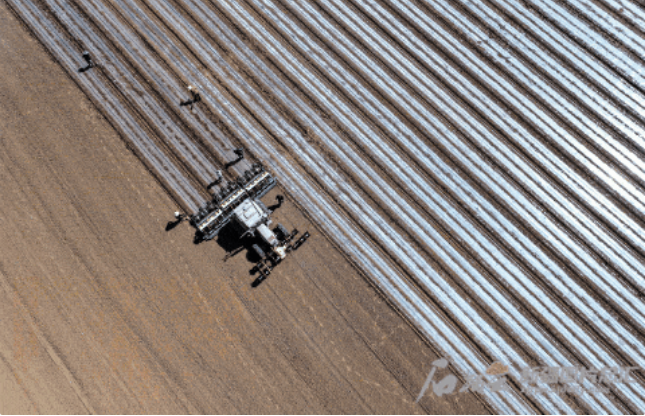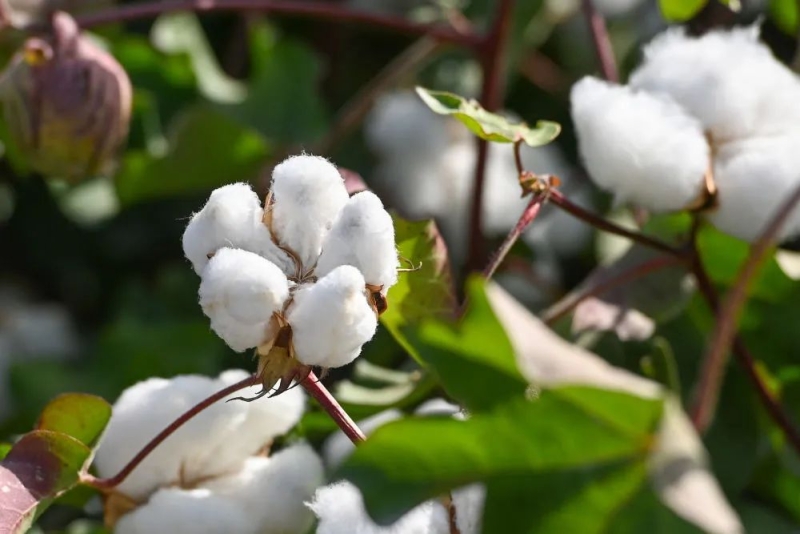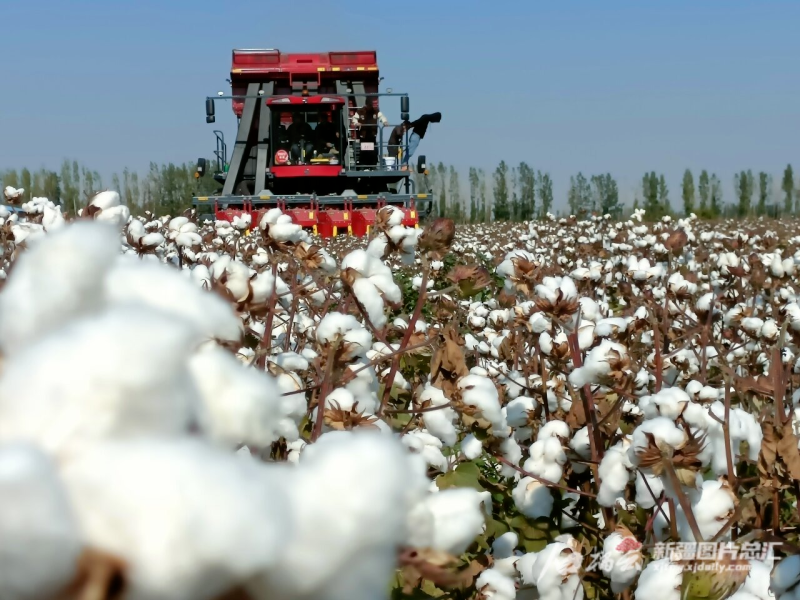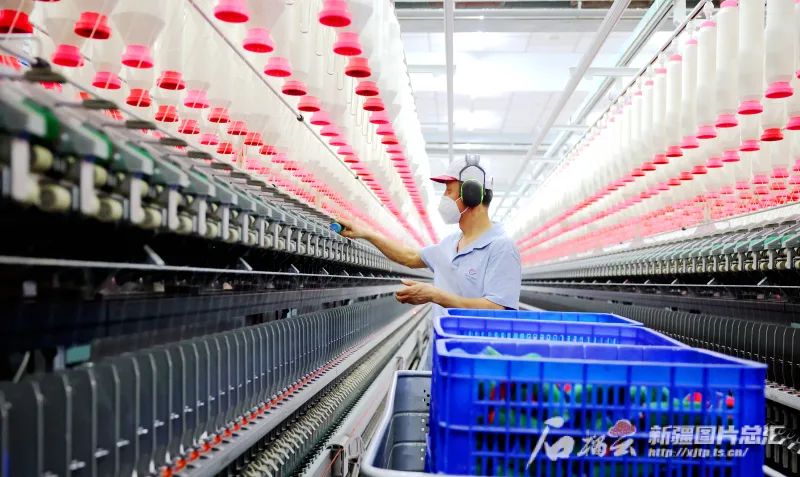In recent days, Xinjiang cotton has once again captured public attention. Earlier this month, a new method for cultivating Xinjiang long-staple cotton and processing its seed cotton, jointly developed by the Institute of Cotton Research of Xinjiang Academy of Agricultural Sciences and Xinya Cotton Industry Co., Ltd. in Awat County, was granted a U.S. invention patent. This marks China's first invention patent authorized in the U.S. in this field.

Aerial photo taken on March 27, 2024 shows integrated precision planters sow cotton in the fields of Liuyuan Town, Aksu City, northwest China’s Xinjiang Uygur Autonomous Region. (Photo by Shiliuyun-Xinjiang Daily/Zhou Peng).
At first glance, this may seem like a typical technical patent application. However, a closer examination reveals that its significance goes well beyond being just a "first." Experts explain that this technology patent effectively tackles challenges in the production and processing of machine-harvested long-staple cotton in Xinjiang, particularly the problem of fiber damage during processing. This issue has a direct impact on the global standing and reputation of Xinjiang's long-staple cotton and will ultimately shape the future of the region's cotton industry.
In essence, this patent has given long-staple cotton a second life.
Let us analyze the two key terms in the news: long-staple cotton and processing methods.
Long-staple cotton is hailed as the pinnacle of cotton. Its fiber length typically ranges from 33 to 39 millimeters or even longer, significantly exceeding that of ordinary cotton. The fibers are strong and resistant to breakage, enabling the spinning of finer and more durable yarns. Garments made from long-staple cotton offer better breath ability and moisture absorption, making it widely used in high-end textiles, home furnishings, and other high-value-added products.
As a premium raw material for cotton textiles, long-staple cotton is not only prized for its quality but also for its scarcity. Its cultivation requires specific environmental conditions and advanced techniques, with production primarily limited to regions such as China, the United States, and Egypt. It can be said that whoever controls the production and supply of long-staple cotton holds the key to the development of high-end textile industries and, naturally, the initiative for industrial transformation and upgrading.

File photo shows the cotton in the demonstration field of the Cotton China Sustainable Development Program in Taerlake Township, Luntai County, Bayingolin Mongolian Autonomous Prefecture, northwest China’s Xinjiang Uygur Autonomous Region. (Photo by Xinhua News Agency/Ding Lei)
Xinjiang is not only the main cotton-producing region in the country but also China's sole producer of high-quality long-staple cotton. It is precisely for this reason that the U.S. and Western countries spare no effort to smear and suppress Xinjiang's cotton industry. One of their underlying goals is to curb the production of Xinjiang's long-staple cotton and the development of related supporting technologies, ultimately forcing the cotton and downstream industries into a disadvantageous position of low development levels and dependence on high-end raw materials.
Now, let’s talk about another key term: processing methods.
Post-harvest processing remains a critical bottleneck constraining the development of Xinjiang's long-staple cotton. Without solving the issues of mechanized harvesting and processing, the long-staple cotton industry in Xinjiang cannot thrive.
The strong production capacity of Xinjiang's cotton is undeniable. In 2024, Xinjiang's total cotton output exceeded five million tons, but the production of long-staple cotton was only about 60,000 tons, accounting for a relatively small proportion.
The natural ecological conditions of Xinjiang's main long-staple cotton-producing areas are not as favorable as those in other regions, such as the United States. The soil fertility of cotton fields in Xinjiang is relatively low, and salinity is high. To overcome these natural shortcomings and fully exploit the potential of existing resources, Xinjiang's agricultural technicians have proposed a long-staple cotton planting method that matches the local natural environment: "short, dense, early, and film-covered" + drip irrigation. Under this unique planting and management technique, the planting density of Xinjiang's long-staple cotton is about twice that of American Pima cotton fields. Additionally, Xinjiang's long-staple cotton has large leaves and more leaf hairs, which leads to poor effectiveness of conventional defoliation and ripening techniques. During mechanical harvesting, more impurities are easily mixed in, and the processing requires additional steps and efforts to remove these impurities. This results in a significant decline in the two key quality indicators of cotton fiber length and strength after processing, leading to the phenomenon of "quality degradation during processing."
Although manual harvesting could avoid these issues, the high labor costs would significantly reduce production efficiency, making it difficult for Xinjiang's long-staple cotton to compete in the market with similar products that have already achieved mechanized production.
A good long-staple cotton brand relies on strong variety resources as well as innovative technologies and processing techniques. Xinjiang has also introduced domestic and international long-staple cotton processing equipment and technologies. However, due to technical incompatibility, the problem of "quality degradation during processing" has not been thoroughly resolved, severely affecting the quality of Xinjiang's long-staple cotton and weakening its competitiveness in the international market against world-class long-staple cotton.
This explains why, despite the impressive total cotton production data in Xinjiang, the production of long-staple cotton seems to be struggling to reach its full potential.

File photo shows a large cotton picker harvests cotton in the fields of Chengzhuangzi New Village, Wulanwusu Town, Shawan City, northwest China’s Xinjiang Uygur Autonomous Region. (Photo by Guan Bing)
While mechanical harvesting compromises fiber quality, manual harvesting incurs high labor costs. A complete technical system must be developed to address this issue and truly transform the resource advantages of Xinjiang's long-staple cotton into economic benefits.
Xinjiang's researchers have been actively engaged in the production, concentrating on the practical needs of industrial development. Taking into account the growth environment and the management characteristics of cotton cultivation in Xinjiang, they have innovatively designed essential methods and equipment for various production stages. These stages include selecting cotton varieties, determining row spacing, defoliation and ripening processes, pre-harvest preparations, and processing techniques. As a result, they have established a comprehensive set of high-quality mechanized methods for producing long-staple cotton that are well-suited to the region. These methods are gradually proving effective in actual production.
After initial promotions and trials, the fiber length, strength, and uniformity of Xinjiang's long-staple cotton processed with this technical solution show no significant quality differences compared to hand-picked cotton. Additionally, the contamination from foreign fibers is significantly lower than in hand-picked cotton. This advancement addresses the long-standing issues associated with the mechanized harvesting and processing of Xinjiang's long-staple cotton, notably improving production levels and enhancing the industry's overall competitiveness.
It's clear that the U.S. patenting of Xinjiang's long-staple cotton production and processing technology is about more than just technological advancement.. It is the result of Xinjiang's long-term commitment to supporting high-quality agricultural development with science and technology. It is also a successful exploration of Xinjiang's long-staple cotton seeking development and opportunities through new productive forces. Xinjiang's long-staple cotton will undoubtedly shine on the global cotton stage in the future.

Photo taken on February 27, 2024 shows a staff member operates spinning machinery at an intelligent workshop of Yida Textile Co., Ltd. in Changji Hui Autonomous Prefecture, northwest China’s Xinjiang Uygur Autonomous Region. (Photo by Liang Hongtao)
"Xinjiang's long-staple cotton now has a tailor-made production and processing technical solution, and its quality control capabilities have gained international recognition," said Tian Liwen, a researcher at the Institute of Cotton Research of Xinjiang Academy of Agricultural Sciences. In the future, researchers will continue to strengthen efforts in tackling core technology in key areas, continuously improve the planting management and processing technology systems that perfectly adapt to Xinjiang's unique ecological environment, further enhance the brand influence of Xinjiang's long-staple cotton, and provide scientific and technological support for the supply of high-end cotton textile raw materials in China and the world.
(Original source: Xinjiang Release, Reporter: Liu Yi)









